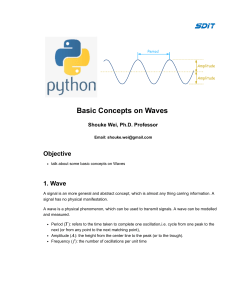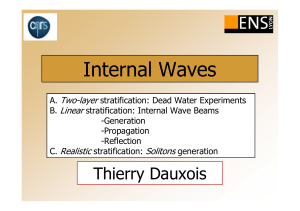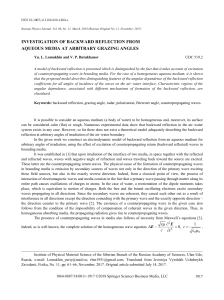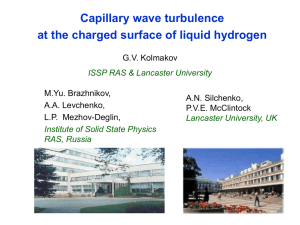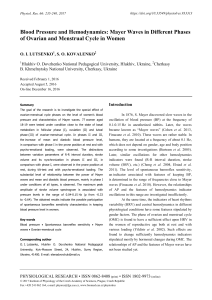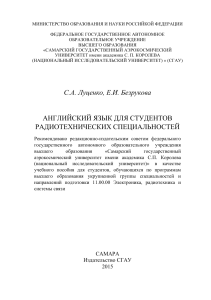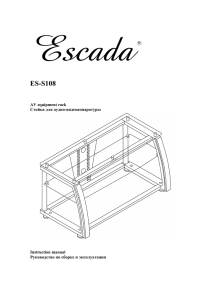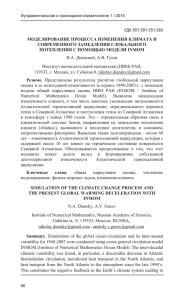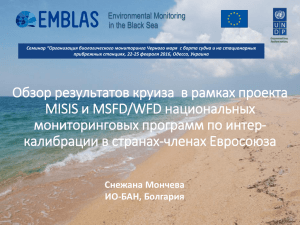Внутренние волны в океане
advertisement

Внутренние волны в океане А.Н. Серебряный Акустический институт имени акад. Н.Н.Андреева (АО АКИН), Институт космических исследований РАН Шестая Школа-семинар «Спутниковые методы и системы исследования Земли», Таруса, 2-6 марта 2015 The deadwater phenomena • “Internal gravity waves in the ocean’s interior are as common as waves at the sea surface – perhaps even more so, for no one has ever reported an interior calm” (Walter Munk). Профессор Манк (справа), академик Л.М.Бреховских и директор Скриппсовского института профессор Нюренберг (слева), 1979 г. Significance of IW in the Ocean • Internal solitary waves are important for many practical reasons. They are ubiquitous wherever strong tides and stratification occur in the neighborhood of irregular topography. • Biology—The turbulence and mixing accompanying ISW often introduce bottom nutrients and surface oxygen, carbon dioxide gases and micro-gas bubbles into the water column, thereby fertilizing the local region and modifying the biology therein • Engineering—Affect offshore drilling operations • Military—Deflect acoustic signal, making tracking submarine difficult • Internal waves can exist whenever there are density stratification in the water column. • Their period ranges from minutes to a several hours and it never exceed the inertial period. • Their frequency f, Coriolis parameter < f < Brunt-Vaisala frequency, where the Coriolis parameter = 2Ωsin φ, Ω – the angular velocity of the Earth’ rotation, φ – geographic latitude • The amplitude of internal waves is a maximum at the boundary between fluids of different densities. Amplitude ranges from few parts of meters to more than 100 m. • «Детальные измерения внутренних волн представляют огромные трудности : помимо того, что требуются инструменты и суда, волны обладают структурой как в вертикальном, так и в обоих горизонтальных направлениях и во времени, на них оказывают сильное влияние изменения стратификации в вертикальном направлении и горизонтальные течения. • Нужны большая изобретательность, чтобы спланировать соответствующие измерения, и мастерство чтобы довести их до конца.» • О.М. Филлипс. Динамика верхнего слоя океана. 1980. С. 192. В гостях у профессора Овена Филлипса (автора книги «Динамика верхнего слоя океана»), в то время главного редактора журнала “Fluid Mechanics”, Университет Джона Хопкинса, Балтимор, США, 2001 г. Исследования внутренних волн в океане • • Л.М.Бреховских указывал на важность детального изучения характеристик внутренних волн в океане. По его инициативе и всемерной поддержке в Акустическом институте были разработаны специальные методы измерений пространственновременных характеристик внутренних волн (с использованием пространственных антенн распределенных датчиков температуры) и проведены эксперименты во многих районах Мирового океана. Коллектив океанологического сектора под руководством К.Д.Сабинина стал признанным мировым лидером по исследованию внутренних волн в океане. Американский ученый физик и океанолог Др. Джон Апел – пионер применения космических методов для исследования внутренних волн в океане. Автор издания «Atlas of Oceanic Internal Solitary Waves», 2004. Location of Reported ISW Observations [Based on Jackson (2004)] Largest internal waves Largest internal waves observed in the World Ocean (sites of the observations, and IW amplitudes in meters ) Largest internal waves observed in the World Ocean № 1 Region South China Sea 2 3 Gibraltar Mascarene Ridge, Indian Ocean 120 90 4 5 85 85 6 7 Sulu Sea Amazonian Shelf (Slope), Atlantic The Bay of Biscay Seishelles, Indian Ocean 8 Andaman Sea 60 9 Equatorial part, Pacific ocean 60 10 11 12 13 Malin Shelf, Atlantic Ocean Australian NW Shelf Portugal Shelf, Atlantic Ocean Nova Scotia Shelf, Atlantic Ocean Messina Strait, Mediterranean Sea 49 45 40 40 14 Height, m 170 80 113 38 References Duda T., Lynch J. et al, 2005; Klymak, Pinkel R., CT Liu, A. Liu et al, 2006; Bryden H.L. et al , Konyaev K., Sabinin K., Serebryany A., 1995 Apel J.R et al, 1985 Kuznetzov A., Paramonov A., Stepanyants Yu.,1984 New A.L., Pingree R.D, 1990 1998Sabinin K., Nazarov A., Serikov A., 1987 Osborne A.R., Burch T.L., 1980 Pinkel R., Merrifield M., McPhaden M. et al., 1997 Small J. Et al, 1999 Holloway P.E, 1987, 1995 Da Silva C.B , et al, 1998 Sandstrom H., Elliott J.A., 1984 Nicolo L., Salusti E., 1991 Astronaut photo of Gibraltar with visible manifestation of packets of internal waves (from Atlas of Oceanic Internal Solitary Waves, 2004) 120-m amplitude solitary internal wave observed in Gibraltar (Figure courtesy of H. Bryden) Huge internal wave of 113-m amplitude. Record of the sound scattering layers obtained from the R/V drifting within the Seyshelles Archipelago in April 1985 ( Sabinin et al). 90-m solitary internal wave near Mascarene Ridge, Indian Ocean NONLINEAR INTERNAL WAVES IN THE SOUTH CHINA SEA Huge internal solitary wave of 155-m height observed in the South China Sea (T. Duda, J. Lynch et al, 2004) Isotherm displacements are shown. The measurements were made at the 350-m deep site by mooring with temperature sensors chain. The black dashed line shows form of KdV soliton. Generation of a hydraulic jump and soliton-like waves above the underwater ridge Isobaths and trajectories of runs and drifts near Mascarene Ridge and radar images of main observed internal wave events Numeric modeling (courtesy of Vlasenko) shows the features of 2-mode (the strong elevation of the upper picnocline) at the western edge of the sill but not describe shorter waves because of lack of resolution. Numeric modeling of processes near the Ridge (courtesy of V.Vlasenko) Spectrum of internal waves (measurements on a shelf of the Sea of Japan) Nonlinear internal tides on the Australian NW Shelf Известный австралийский ученый-океанолог Питер Холловей, специалист по внутренним волнам. Фото сделано в Университетском колледже Университета Нового Южного Уэльса, Канберра, в 2000 г. Satellite image of the Australian Northwest Shelf with surface manifestations of tidally generated packets of internal waves (11 Oct. 2001). Imaged area is 60 km x 60 km (Atlas of Oceanic Internal Solitary Waves, 2004) Генерация внутренней приливной волны при подходе баротропного приливного течения к шельфу (по Дж. Симпсону, Физическая и биологическая океанография шельфовых морей, 2012) Moorings and bathimetry (4- month observations on the NW Shelf of Australia). Forms of internal tides TRANSFORMATION OF WAVE WITH BORE ON FRONT FACE INTO SQUARE WAVE temperature, C SHF BRK SLP TRANSFORMATION OF WAVE WITH BORE ON BACK FACE INTO SQUARE WAVE temperature, C SHF BRK SLP Main features of internal tides on the Australian NW Shelf (Holloway, Serebryany, 2002) The internal tide generated over the slope region been largely linear in its properties in deep water propagating over the shelf break becomes strongly nonlinear. Internal tidal wave develops into several typical nonlinear forms of long wave. Besides “bore on front face of wave”, widespread and well-known form of nonlinear internal wave documented in many observations, “bore on back face of wave” and “square wave” are as well widespread and relatively long-living forms of internal tide near break. All mentioned forms can transforms each to other during internal tide travelling above shelf. The causes of origin of “square wave” and “bore on back face” are in fundamental specifical characteristics of medium (in stratification and background currents) through which the waves propagate. SW06 experiment ERS satellite image (15:36 23 July 2006) with depth contours and mooring positions. The image is an evidence of strong interaction of the internal waves with the sea surface. Train of intense internal waves observed on August, 19, as it seen from temperature contours. It is clear manifested nonlinear character of the waves in their depression forms Internal wave characteristics: depression waves on a sharp subsurface thermocline; tidal periodicity of internal wave train occurrence; direction of propagation ~ 300 N; heights: 10-15 m, up to 25 m; period: 5-9 min; length: several hundred meters; speed: ~ 1 m/s; and strong orbital currents Spectrogram for the leading six waves of internal wave train, August, 19 (top) and isotherm displacements for the same time interval (dawn) Geography of observations of internal waves on shelves of the former Soviet Union carried out by us for 25-year period STUDY AREAS IN THE BLACK SEA The Black Sea Line temperature sensor (Konyaev, Sabinin, 1973) is an insulated vertical stretched wire of tens of meters in length. Its resistance changes in proportion to the average temperature of the layer in over which it is stretched. The response of the LS to vertical displacements of the water layers is proportional to the vertical temperature gradient averaged over the length of the sensor, and it is more stable than the response of the point sensor. Such stability allows one to convert temperature data obtained by the LS into data of vertical displacement of the layer where the sensor is situated. Platform on shelf of the Caspian Sea (20 km offshore, near Baku), from which we carried out long-term observations of internal waves of non-tidal origin Oceanographical platform of Marine Hydrophysical Institute of Ukrainian Academy of Science, the Black Sea, Crimea, Katsiveli Investigations of internal waves on shelves with using ADCP «Rio Grande 600 kHz» gave us possibility to see the processes in more detail На яхте «Светлана» (ТОИ ДВО РАН) с помощью ADCP ведем измерения в Японском море. Во время рейса на НИС «академик Сергей Вавилов» в Баренцевом море, 1998 г. Это фото использовал Гражданский фонд фундаментальных и прикладных исследований Америки (CRDF) в качестве своей заставки на вебсайте . Изменчивость вертикального профиля температуры из-за внутренних волн в бесприливном Черном (слева) и приливном Японском (справа) морях Processes responsible for generation of internal soliton-like waves on a shelf ( Generation of internal soliton-like waves during approach to the coastal zone local fronts of up- and downwelling origin Generation of internal waves by moving surface intrusions T, C S, o Train of internal waves, registered at a moment of passing of intrusion front (line temperature record) Results of numeric modeling (Pao and Serbryany, 2002) Coastal front generated due to strong storm. Passage of the front is accompanied by train of intense internal waves Генерация внутренних волн при столкновении течений . Distribution of the modulus of the current velocity in depth on the tack (left) and trajectory of the tack on September, 21, 2005 with map of study area (right) Distribution of the velocity magnitude in depth on the tack (top) and pattern of the volume backscattering on the tack. train 2 train 1 The position of picnocline and two areas of intense internal waves can be clear seen. The wave heights in train N1 reach values of 8 m. In the coastal zone, a typical length of the waves is 250 m while it is 600 m near the front. Distribution of the velocity magnitude in depth on the tack (top) and temperature dependence obtained by using CTD at 11 equidistant points on the tack. The length of the tack is 23 km. PROCESSES RESPONSIBLE FOR SOLITON-LIKE INTERNAL WAVES GENERATION ON A SHELF Surface tide Internal tide Halpern, 1971; Holloway, 1987; Serebryany, 1985; Apel, Liu, 1985; Colosi et al, 2001 Internal tide disintegration Wind action Near-inertial internal waves Ivanov, Serebryany, 1985; Kim et al, 2001 Collisions of currents Internal seiches Ivanov et al, 1981 Serebryany, 2008 Local fronts of up Surface intrusions and downwelling origin Ivanov, Serebryany, 1985 Ivanov, Serebryany, 1983; Serebryany, Pao, 2001; Nash, Moum, 2005 Nonlinear effects in observed internal waves Typical sinusoidal form of internal waves on shelf in the case of small amplitude (1-2 meters). Observations in the Black and Caspian Sea. Typical sinusoidal form of internal waves in deep ocean in the case of small amplitude (5 meters). Observations in the tropical Pacific. The vertical asymmetry of internal waves (depression and elevation waves) The vertical asymmetry of internal wave profiles as registered by line temperature sensors. Train of intense internal waves for the case of a subsurface thermocline (wave depressions)(upper) and for the case where the thermocline is close to the bottom (wave elevations)- (lower) Wave depressions and elevations (with heights up to 10 m are propagating to the shore, the Sea of Japan) The horizontal asymmetry of internal waves. Measurements made by two line temperature sensors separated by a 25- m distance perpendicular to the shoreline in the coastal zone in September, 1982 (Serebryany 1985) (left picture). Record made by towing the ADCP in the close area (September, 2004) (right picture) Цуги интенсивных волн с предвестниками: запись РДТ (вверху) и ADCP (внизу) • The KdV equation 3 c0 3 0 t t t x 0 3с 0 H 0 Nonlinearity coefficient ( 2 ( H dW 3 ) dz dz dW 2 ) dz dz 0 с0 Dispersion coefficient W 0 H A сs с0 (1 ) 3c0 dz H 2 ( Solution to KdV: 2 dW 2 ) dz dz x , t 0 sec h 2 x ct / L 1 2 21 Ls ( ) A Manifestation of soliton properties: evidences of dependency between internal wave speed and amplitude CS =C0(1+A/3C0) Internal bore (from observations on the Caspian Sea) Effect of change of internal wave polarity Sketch, demonstrating the effect of change of internal wave polarity for case of shoaling train of depression waves. The coefficient of nonlinearity, , changes sign in the zone where H1=H2 (“overturning point”), indicated by two question-marks. The first evidence of the effect of change of internal wave polarity in the field observations in the sea Elevation waves Depression waves Observations were made on shelf of the Sea of Japan in 1982 (Serebryany, Oceanology, 1985). Another evidences of the effect were obtained by Salusti et al. in Mediterranean Sea, 1986, and Orr in South China Sea, 2001. Record of solitary internal wave in the zone of “overturning point” Thermocline was near the sea surface before the wave approach. Vertical temperature profiles made in typical moments (arrows) (c,d). Bottom relief and position of anchored research vessel (b). Numerical simulation of the observational process was carried out on the basis of solving full Navier-Stokes and diffusion equations 1 1 ( u) ( w) 2 t Q x z Re Sc 1 Q 1 2 ( u ) ( w) 2 t Q x z F x Re ρ1 h1 ρ1 ρ2 Where vorticity ξ is determined as follows: Δh h2 d L SC 2 ΔL Q2 u w Q z x And stream function ψ is defined as follows: Z X u z L w 1 Q x Other parameters are: Q = L/d, γ = (ρ1-ρ2)/ρ2. Fr=0.0156, Re=10000 Sc=10, L=4200 м, d=70 м Initial configuration of a model for numerical simulation (variant of a two-layered fluid). Reservoir with scales ΔL and Δh supplies initial potential energy for internal wave generation. Results of modeling: transformation of solitary wave before turning point (Pao, Serebryany, 2002) Results of modeling: transformation of solitary wave passing through turning point Surface manifestations of internal waves Slick on the sea surface induced by an internal wave moving shoreward to the Kamchatka coast, Pacific Ocean Close view of a slick generated by a solitary internal wave at the Kamchatka shelf Position of slick and ripp band for cases of internal wave elevation and depression Slicks in the entrance of Vityaz Bay, the Sea of Japan. Внутренние волны над порогом у входа в б. Витязь Слик над шельфом Японского моря (23.09.2004) Внутренняя волна, сгенерировавшая слик на поверхности моря (измерения 23 сентября 2004 г) Map of CTD survey during cruise OR1(796), May 21-26, 2006, Head – Dr. Wen and sites of measuring ambient nose generated by internal waves (S1 and S2) Фотоизображения экрана судового локатора, сделанные в моменты подхода к судну уединенной полосы сулоя 23 мая: в 11:42:32 (слева) и в 11:48:10 (справа). Ширина полосы сулоя 1300 м. Photo taken during passage of one of rip bands on May 24 Морская поверхность во время прохождения уединенной внутренней волны (слева) и после (справа). Наблюдения 23 мая. Radar image of 2-mode solitary wave (wind of 10-12 m/s) Radar image of 90-m solitary wave (calm weather) Generation of ambient nose by largeamplitude internal wave in the ocean 50-m solitary internal wave generated noise: (right) radar image of the rip band, generated by solitary internal wave made at 3:00 (loc. time) on 6 December, 1990; (left) - record of the internal wave made by line temperature sensor (vertical displacement of thermocline). Sea surface in the moment of passing of strong internal wave. (Choppy waves, rippes, white caps, suloy) Measurements of internal wave were made by: line temperature sensor and “yo-yo” CTD soundings, radar images (photographed). Measurements of noise were made by antenna of 4 vertically distributed hydrophones (5-100 kHz) and one low-frequency hydrophone (0.120 kHz) arranged at depth of 100 m. a. Variations of level of underwater nose registered by omnidirectional hydrophone (low-frequency 0.1-20 kHz) in wide frequency band in the time of the solitary wave passing. б. Spectral levels of the noise observed at moments marked by digits 1,2,3,4 on fig.a (high-frequency 5-100 kHz). b. Coherency functions. The moment of arising of noise level on receiving hydrophone coincides with the moment of rip band arriving to the position of antenna. Passing of the internal wave lead to significant increase (up to 18 dB) of underwater noise level at frequency in a range of 5-15 kHz. Other important effects connected with internal waves Strong horizontal refraction of sound due to internal solitons (Nekrasov, Serebryany, 2004). It was found significant horizontal refraction of sound on a shelf due to internal depression and elevation waves. A study was carried out by numeric modeling on the basis 3D-ray method. For the case of 10-km acoustic path the horizontal refraction due to action of train of internal elevation waves achieves as much as 7 degrees. Effect of internal waves on subsurface layer of air bubbles in the sea (Modulation of thickness of the subsurface bubble layer by passing internal waves) An explanation of the effect due to orbital currents induced by passing internal waves Strong interaction of internal waves with the bottom. Solitonlike internal waves propagating above underwater bank and generating “dune-solitons”on the bottom relief. Heights of these underwater dunes are as much as 6 m. Lense of warm and salty water in the shelf zone of the Sea of Japan Average backscatter contour obtained by ”Rio- Grande 600 kHz” ADCP (observations on September,17, 2004), where we saw lense with horizontal spatial extension of up to 3 kms. The lens is above the depth of 29 m. Acoustically, the lens is seen very clearly due to enhancement of sound backscattering by the water mass forming the lens Temperature profile as functions of the depth and time, July of 2011, Black Sea. Inertion internal waves. Observations of mode 1 Starting from July 9, we recorded passing five periods of the first-mode quasiinertial internal waves whose heights reached 8 to 16 m. Simultaneously, oscillations of the sound speed were as high as 10 m/s at some horizons. Oscillations of the sound-speed isopleths under the influence of the firstmode quasi-inertial internal waves (July 11 to 12). At the right, vertical profiles of the sound speed are shown for characteristic times of July 11 (1 4.00, 2 - 23.00, and 3 - 12.00 hrs). Observations of mode 2 Oscillations of the sound-speed isopleths under the influence of the secondmode inertial internal waves (July 17 to 18). Vertical profiles of the sound speed for characteristic times of July 17 (1 - 6.00, 2 - 14.00, and 3 24.00 hrs). The oscillations of the sound speed reach 20 m/s. Internal waves are around us. Breaking internal wave in air stratified flow above the hill (coast of the Sea of Japan) Thank you for your attention
